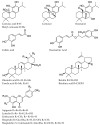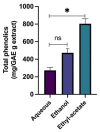Phytochemical Screening of Rosmarinus officinalis L. as a Potential Anticholinesterase and Antioxidant-Medicinal Plant for Cognitive Decline Disorders
- PMID: 35214846
- PMCID: PMC8877369
- DOI: 10.3390/plants11040514
Phytochemical Screening of Rosmarinus officinalis L. as a Potential Anticholinesterase and Antioxidant-Medicinal Plant for Cognitive Decline Disorders
Abstract
The inhibition of acetylcholinesterase (AChE) by cholinergic agents has been promoted as a potent strategy for treating and managing cognitive decline disorders. A wide range of natural products has long been used as potential sources or formulations of cholinergic inhibitors. Therefore, this study aimed to evaluate different Rosmarinus officinalis L. (R. officinalis) extracts for their AChE inhibitory activity using galanthamine as a standard AChE inhibitor. In this study, the ethyl-acetate extract (at a concentration of 250 µg/mL) exhibited the greatest inhibitory effect against AChE with significant inhibition of 75%, comparable to the inhibitor galanthamine with an inhibition of 88%. Kinetic analysis revealed that the extracts could induce a mixed type of inhibition, as observed in the case of galanthamine, with the highest increased Km and decreased Vmax values in the ethyl acetate extract. The antioxidant potential of the three extracts tested was found to be in the order of ethyl-acetate > ethanol > aqueous, with IC50 values of 272 µg/mL, 387 µg/mL, and 534 µg/mL, respectively. Ethyl-acetate was found to have the highest total phenolic content in all extracts. Further, in silico study showed structural binding characterization of rosmarinic acid and carnosic acid with human AChE enzyme. Rosmarinic acid showed strong binding and formed two hydrogen-bonding interactions with Ser-293 and Arg-296. In light of this, the ethyl-acetate extract of the plant may provide some novel potential pharmacological leads for treating and managing cognitive disorders such as Alzheimer's.
Keywords: Alzheimer’s disease; Rosmarinus officinalis; acetylcholinesterase; carnosic acid; molecular docking; rosemary; rosmarinic acid.
Conflict of interest statement
The authors declare no conflict of interest. This research did not involve any animal and/or human participant.
Figures









Similar articles
-
Inhibitory effect of Turkish Rosmarinus officinalis L. on acetylcholinesterase and butyrylcholinesterase enzymes.Food Chem. 2008 May 15;108(2):663-8. doi: 10.1016/j.foodchem.2007.11.023. Epub 2007 Nov 19. Food Chem. 2008. PMID: 26059146
-
Scrophularia lucida L. as a valuable source of bioactive compounds for pharmaceutical applications: In vitro antioxidant, anti-inflammatory, enzyme inhibitory properties, in silico studies, and HPLC profiles.J Pharm Biomed Anal. 2019 Jan 5;162:225-233. doi: 10.1016/j.jpba.2018.09.035. Epub 2018 Sep 18. J Pharm Biomed Anal. 2019. PMID: 30268023
-
In silico and in vitro elastase inhibition assessment assays of rosmarinic acid natural product from Rosmarinus officinalis Linn.Nat Prod Res. 2024 Feb-Mar;38(5):879-884. doi: 10.1080/14786419.2023.2196077. Epub 2023 Apr 2. Nat Prod Res. 2024. PMID: 37004998
-
Rosmarinus officinalis L.: an update review of its phytochemistry and biological activity.Future Sci OA. 2018 Feb 1;4(4):FSO283. doi: 10.4155/fsoa-2017-0124. eCollection 2018 Apr. Future Sci OA. 2018. PMID: 29682318 Free PMC article. Review.
-
Harnessing Essential Oils for Acetylcholinesterase Inhibition: A Literature Review.Phytother Res. 2025 May 12. doi: 10.1002/ptr.8512. Online ahead of print. Phytother Res. 2025. PMID: 40356219 Review.
Cited by
-
Rosmarinus officinalis and Methylphenidate Exposure Improves Cognition and Depression and Regulates Anxiety-Like Behavior in AlCl3-Induced Mouse Model of Alzheimer's Disease.Front Pharmacol. 2022 Aug 12;13:943163. doi: 10.3389/fphar.2022.943163. eCollection 2022. Front Pharmacol. 2022. PMID: 36034857 Free PMC article.
-
Phytochemical Constituents and Biological Activity of Wild and Cultivated Rosmarinus officinalis Hydroalcoholic Extracts.Antioxidants (Basel). 2023 Aug 18;12(8):1633. doi: 10.3390/antiox12081633. Antioxidants (Basel). 2023. PMID: 37627628 Free PMC article.
-
Recent advancements in the role of phytochemicals and medicinal plants in prophylaxis and management of Alzheimer's disease.Iran J Basic Med Sci. 2024;27(11):1357-1369. doi: 10.22038/ijbms.2024.77760.16826. Iran J Basic Med Sci. 2024. PMID: 39386232 Free PMC article. Review.
-
Polyphenols Investigation and Antioxidant and Anticholinesterase Activities of Rosmarinus officinalis L. Species from Southwest Romania Flora.Molecules. 2024 Sep 18;29(18):4438. doi: 10.3390/molecules29184438. Molecules. 2024. PMID: 39339433 Free PMC article.
-
Antioxidant Activities of Ethanolic Extracts Obtained from α-Pinene-Containing Plants and Their Use in Cosmetic Emulsions.Antioxidants (Basel). 2024 Jul 4;13(7):811. doi: 10.3390/antiox13070811. Antioxidants (Basel). 2024. PMID: 39061880 Free PMC article.
References
-
- NIH Alzheimer’s Disease Fact Sheet. [(accessed on 16 October 2021)];2021 July 8; Available online: https://www.nia.nih.gov/health/alzheimers-disease-fact-sheet.
-
- Matthews K.A., Xu W., Gaglioti A.H., Holt J.B., Croft J.B., Mack D., McGuire L.C. Racial and ethnic estimates of Alzheimer’s disease and related dementias in the United States (2015–2060) in adults aged ≥65 years. Alzheimers Dement. 2019;1:17–24. doi: 10.1016/j.jalz.2018.06.3063. - DOI - PMC - PubMed
Grants and funding
LinkOut - more resources
Full Text Sources

